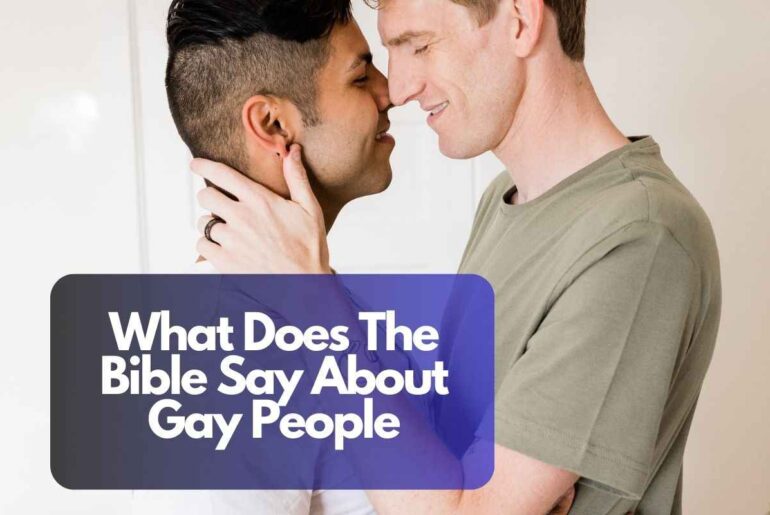As society has become more inclusive and accepting of diverse sexual orientations, individuals and religious groups have grappled with reconciling their beliefs with the evolving understanding of human sexuality. Consequently, the question arises: What does the Bible actually say about gay people?
In this article, we embark on a nuanced exploration of the biblical perspectives on homosexuality. It is important to approach this topic with sensitivity, acknowledging that there are varying interpretations and understandings within different religious traditions. Our aim is to shed light on the different scriptural passages often referenced in discussions surrounding homosexuality and to provide a comprehensive overview of the diverse perspectives within religious communities.
Contents
What Does The Bible Say About Gay People
Homosexuality refers to a sexual or romantic attraction between individuals of the same sex. It is important to note that sexual orientation is an innate and deeply ingrained aspect of a person’s identity, and it is not a choice or a result of external influences.
Importance of understanding biblical perspectives on homosexuality
Understanding biblical perspectives on homosexuality is significant because the Bible holds a central role in the lives of many individuals and faith communities. For Christians, in particular, the Bible is considered a sacred text and a guide for moral and ethical living. As such, exploring what the Bible says about homosexuality helps believers form their understanding of this topic and its implications for their faith and interactions with others.
The Bible has been interpreted in various ways when it comes to the issue of homosexuality. Some interpretations view same-sex relationships as sinful, while others argue for inclusion and acceptance of LGBTQ+ individuals within the faith community. By examining the biblical perspectives on homosexuality, individuals can engage in informed discussions, foster empathy, and develop their own beliefs regarding this matter.
Historical Context
Cultural and social context during biblical times
To understand the biblical perspectives on homosexuality, it is essential to consider the cultural and social context during the time when the Bible was written. The events described in the Bible span several centuries and encompass diverse cultures, including ancient Israel, the surrounding nations, and the Greco-Roman world.
During biblical times, ancient Israel was a patriarchal society with a strong emphasis on family and lineage. The Israelites were deeply influenced by their religious beliefs and practices, which shaped their understanding of relationships, sexuality, and moral standards.
Views on same-sex relationships in ancient cultures
Various ancient cultures had different attitudes toward same-sex relationships. For instance, in Mesopotamia and Egypt, there is evidence of same-sex eroticism and relationships depicted in artwork and literature. In some cases, these relationships were associated with religious rituals or rites of passage.
In ancient Greece, same-sex relationships were a notable feature of society. The Greeks acknowledged a range of same-sex relationships, including pederasty (an educational and mentorship relationship between an older man and a younger man) and relationships between adult men. These relationships were seen as a part of social and educational practices, but they were often limited to specific social classes or age groups.
Jewish and Greco-Roman attitudes toward homosexuality
In ancient Jewish society, the Torah (the first five books of the Hebrew Bible) provided the foundation for religious and moral guidance. Leviticus 18:22 and 20:13 in the Old Testament are commonly cited verses that are interpreted as condemning same-sex sexual relations.
In Greco-Roman culture, the prevailing attitudes towards same-sex relationships were complex. While homosexuality was not universally accepted or celebrated, there were instances of same-sex relationships and sexual encounters within various social contexts. However, certain moral and philosophical discourses, such as Stoicism, criticized same-sex relations or advocated for self-control and heterosexual marriage.
Key Bible Verses
Leviticus 18:22 and 20:13
1. Interpretation of the Old Testament verses: Leviticus 18:22 states, “You shall not lie with a male as with a woman; it is an abomination.” Leviticus 20:13 affirms, “If a man lies with a male as with a woman, both of them have committed an abomination; they shall surely be put to death; their blood is upon them.” These verses are often cited as evidence of biblical condemnation of same-sex relationships.
Interpretations of these verses vary. Traditional or conservative interpretations view them as clear condemnations of homosexual behavior, considering it a sin or an abomination. However, it is crucial to acknowledge that the prohibitions in Leviticus form part of the broader Levitical law, which includes various regulations pertaining to cleanliness, purity, and holiness. This context is essential when interpreting these verses.
2. Historical context and relevance: The book of Leviticus was written during a specific historical and cultural context, where ancient Israelites sought to maintain their distinct religious and social identity. The prohibitions against same-sex sexual activity in Leviticus are situated within a broader framework of moral and ritual laws. They reflect the ancient Israelites’ particular understanding of sexual norms and were intended to set them apart from surrounding cultures.
New Testament references
1. Romans 1:26-27: In Romans 1:26-27, the apostle Paul writes, “For their women exchanged natural relations for those that are contrary to nature; and the men likewise gave up natural relations with women and were consumed with passion for one another, men committing shameless acts with men and receiving in themselves the due penalty for their error.”
This passage has been traditionally understood as a condemnation of same-sex sexual activity. However, interpretations differ. Some argue that Paul was addressing specific cultural practices or referring to excessive lust and unnatural behavior rather than same-sex relationships based on love and commitment.
2. 1 Corinthians 6:9-10 and 1 Timothy 1:9-10: Both 1 Corinthians 6:9-10 and 1 Timothy 1:9-10 list various vices, including arsenokoitai (a Greek term often translated as “homosexual offenders” or similar phrases) as condemned behaviors. These verses have been interpreted as references to same-sex sexual activity.
Analysis of the Verses’ meaning and intent
Analyzing the meaning and intent of these verses requires considering the historical, cultural, and linguistic contexts in which they were written. It is essential to approach them with humility, recognizing that interpretations have evolved over time and continue to be diverse among scholars and religious communities.
Engaging in respectful dialogue and studying various scholarly interpretations can shed light on the complexities of these biblical passages. Understanding the historical context, the specific concerns addressed by the biblical authors, and the overarching themes of love, justice, and grace in the Bible can help individuals develop their own understanding and perspective on the issue of homosexuality in relation to their faith.
Different Interpretations
Traditional/conservative interpretations
1. Understanding homosexuality as a sin: Traditional or conservative interpretations generally view homosexual behavior as a sin. This viewpoint is rooted in the belief that the Bible’s teachings on sexuality, particularly the verses mentioned earlier, explicitly condemn same-sex relationships. It is seen as a violation of God’s design for human sexuality, which is believed to be exclusively within the context of heterosexual marriage.
2. Arguments supporting this viewpoint: Supporters of the traditional/conservative interpretation often base their arguments on the belief that the Bible is the authoritative word of God and should be interpreted literally or within the historical and cultural context of the original writings. They emphasize that the biblical passages specifically address same-sex sexual activity and argue that any departure from the heterosexual norm is contrary to God’s intentions for human relationships.
Progressive/affirming interpretations
1. Reexamining cultural context and relevance: Progressive or affirming interpretations take a more inclusive and accepting stance towards LGBTQ+ individuals and relationships. Proponents of this viewpoint argue that a reexamination of the cultural and historical context is crucial for understanding the intended meaning of the biblical passages on homosexuality.
They assert that the biblical authors were primarily addressing specific cultural practices or exploitative forms of same-sex behavior prevalent in their time, rather than consensual, loving, and committed same-sex relationships as understood today. They contend that the ancient cultural norms and understanding of sexuality differed significantly from contemporary understandings, and thus, a more nuanced interpretation is necessary.
2. Arguments supporting inclusion and acceptance: Supporters of progressive/affirming interpretations argue for the inclusion and acceptance of LGBTQ+ individuals within faith communities. They emphasize the overarching biblical principles of love, justice, and equality, suggesting that these principles should guide the understanding of sexuality and relationships.
Advocates for inclusion also point to the teachings and example of Jesus, who emphasized love, compassion, and the inclusion of marginalized individuals. They argue that exclusion or condemnation of LGBTQ+ individuals contradicts the message of Christ and promotes discrimination and harm.
Progressive/affirming interpretations often draw upon contemporary scientific, psychological, and sociological research to challenge the notion that homosexuality is a choice or a psychological disorder. They emphasize the importance of interpreting the Bible through the lens of love, empathy, and a commitment to justice for all individuals, regardless of their sexual orientation or gender identity.
Theological and Ethical Considerations
Understanding the Bible’s broader message of love and compassion
When exploring the biblical perspectives on homosexuality, it is crucial to consider the broader message of love, compassion, and justice that permeates the Bible. The teachings of Jesus Christ emphasize the commandment to love one another and to treat others with kindness and respect. This overarching message invites Christians to approach discussions about homosexuality with empathy and a desire to promote understanding and inclusion.
Recognizing the importance of interpreting scripture in context
Interpreting scripture in its historical, cultural, and literary context is essential for understanding the intended meaning of biblical passages, including those related to homosexuality. This requires examining the original language, cultural practices, and the specific concerns addressed by the biblical authors. Taking the context into account helps to avoid misinterpretations or the imposition of modern assumptions onto ancient texts.
Examining the role of cultural and historical biases
It is vital to acknowledge that cultural and historical biases can shape interpretations of scripture. The biblical texts were written within specific cultural contexts, influenced by the social norms, beliefs, and practices of their time. These cultural factors can impact how certain topics, including homosexuality, are addressed within the Bible.
Examining cultural and historical biases helps to discern whether certain passages reflect the timeless moral principles underlying God’s will or if they were specific to the cultural context in which they were written. Understanding the influence of cultural biases aids in developing a more nuanced and informed interpretation of the Bible’s teachings on homosexuality.
Contemporary Christian Views
Diverse Perspectives within Christianity
Contemporary Christianity encompasses a wide range of perspectives on the topic of homosexuality and LGBTQ+ inclusion. While traditional or conservative views that interpret biblical passages as condemning same-sex relationships still exist, there has been an emergence of more progressive or affirming views that advocate for the full inclusion and acceptance of LGBTQ+ individuals within the faith community.
Within these broad categories, there is further diversity in the way individuals and denominations approach the issue. Some Christians may hold nuanced views that acknowledge the complexity of the topic, while others may find themselves in between traditional and progressive positions. It is important to recognize and respect this diversity of perspectives within Christianity.
Views on same-sex relationships and LGBTQ+ inclusion
Traditional or conservative views generally maintain that same-sex relationships are contrary to biblical teachings and therefore sinful. This perspective may advocate for celibacy or encourage individuals with same-sex attractions to pursue reparative therapy or conversion therapy.
Progressive or affirming views emphasize inclusion, acceptance, and affirmation of LGBTQ+ individuals within the Christian community. They argue that same-sex relationships can be based on love, commitment, and mutual respect and that such relationships should be recognized and celebrated within the faith community. Proponents of these views often advocate for marriage equality and the ordination of LGBTQ+ clergy.
There are also middle-ground perspectives that seek to engage in dialogue and bridge the gaps between different viewpoints. These individuals and communities strive to create spaces of inclusion and acceptance while wrestling with the scriptural and theological complexities surrounding homosexuality.
Impact of changing societal attitudes on Christian theology
Changing societal attitudes towards homosexuality and LGBTQ+ rights have had a significant impact on Christian theology and discussions within the faith community. As societies become more accepting and supportive of LGBTQ+ individuals, some Christians have reconsidered their interpretations of biblical passages related to homosexuality.
For some Christians, this shift in societal attitudes has prompted a reevaluation of their understanding of scripture, leading to more affirming and inclusive interpretations. They argue that the biblical message of love, justice, and inclusivity calls for a reexamination of traditional views on homosexuality.
Conversely, others may perceive changing societal attitudes as a departure from traditional biblical teachings, leading to a reaffirmation of more conservative positions on the issue.
Personal Faith and LGBTQ+ Identity
Navigating faith and sexual orientation/gender identity
Many individuals who identify as LGBTQ+ and have a Christian faith face unique challenges in reconciling their sexual orientation or gender identity with their religious beliefs. Navigating this intersection requires thoughtful reflection, self-acceptance, and seeking a supportive community that affirms both their faith and their identity.
Some LGBTQ+ individuals may experience tension between their sexual orientation or gender identity and traditional interpretations of scripture. They may grapple with questions of acceptance, belonging, and the possibility of living a fulfilling life while maintaining their faith. It is a deeply personal journey that involves seeking understanding, engaging in theological study, and finding support from communities that embrace and affirm their LGBTQ+ identity.
Personal testimonies and experiences
Personal testimonies and experiences of LGBTQ+ individuals who are also people of faith can provide valuable insights and inspiration. These testimonies often highlight the complexities of navigating the intersection of faith and LGBTQ+ identity, demonstrating the diversity of journeys and perspectives within the LGBTQ+ Christian community.
Listening to personal stories can help LGBTQ+ individuals find solace and encouragement, realizing that they are not alone in their struggles. It can also challenge misconceptions and stereotypes, fostering empathy and understanding among others who may be grappling with similar questions or seeking to support their LGBTQ+ friends and family members.
Resources and support for LGBTQ+ Christians
There are various resources and support networks available for LGBTQ+ individuals seeking to reconcile their faith and sexual orientation or gender identity. These resources can offer guidance, theological perspectives, and a sense of community.
Supportive churches or faith communities that embrace LGBTQ+ inclusion can provide a safe and affirming space for individuals to explore their faith and identity. These communities may have LGBTQ+ support groups, educational programs, and clergy or spiritual leaders who are knowledgeable and affirming.
There are also numerous books, websites, podcasts, and organizations dedicated to exploring LGBTQ+ issues within a Christian context. These resources offer theological reflections, personal stories, and practical guidance for LGBTQ+ individuals navigating their faith and identity.
It is important for LGBTQ+ individuals to seek out resources and support networks that align with their own beliefs and experiences. Finding a community that fully accepts and embraces their LGBTQ+ identity while affirming their faith can be instrumental in their spiritual and personal growth.
Conclusion
In this exploration of what the Bible says about gay people, we have covered several important aspects. We began by defining homosexuality and highlighing the significance of understanding biblical perspectives on the topic. We then delved into the historical context, examining the cultural and social factors during biblical times, as well as the views on same-sex relationships in ancient cultures and Jewish and Greco-Roman attitudes towards homosexuality.
We then explored key Bible verses related to homosexuality, such as Leviticus 18:22 and 20:13 in the Old Testament and Romans 1:26-27, 1 Corinthians 6:9-10, and 1 Timothy 1:9-10 in the New Testament. We analyzed the interpretation, historical context, and relevance of these verses, seeking to understand their intended meaning and intent.
We also examined contemporary Christian views on same-sex relationships and LGBTQ+ inclusion, recognizing the diversity of perspectives within Christianity and the impact of changing societal attitudes on Christian theology. Finally, we explored the personal aspects of faith and LGBTQ+ identity, discussing the navigation of faith and sexual orientation/gender identity, personal testimonies and experiences, and available resources and support for LGBTQ+ Christians.
This topic invites further study, reflection, and dialogue. Understanding the Bible’s teachings on homosexuality is a complex and multifaceted endeavor that requires ongoing exploration and engagement. As individuals, communities, and society continue to evolve, it is important to approach this subject with an open mind and a commitment to seeking truth and understanding.
Further study can involve reading various theological perspectives, engaging in respectful conversations with individuals holding different viewpoints, and exploring the experiences and stories of LGBTQ+ individuals within the Christian faith. Such endeavors can deepen our understanding, challenge our assumptions, and promote empathy and unity within the Christian community.
Lastly, it is essential to recognize the sensitivity and deeply personal nature of discussions surrounding homosexuality and LGBTQ+ inclusion. Engaging in respectful conversations, characterized by empathy, humility, and a commitment to love and understanding, can foster unity amidst diversity. It is through such conversations that we can grow in our faith, challenge our own perspectives, and build bridges of compassion and acceptance.








